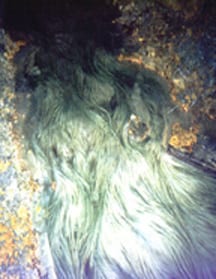New Iron-Eating Microbe Major Component of Mining Pollution and Iron and Sulfur Cycling
March 10, 2000
A new microbe that eats iron and lives in some of the most acidic conditions found on earth has been identified as a major player in the environmental damage caused by metal ore mining. It also raises questions about the ability of microbes to survive in extremely toxic environments on earth or on other planets, and what role these organisms play in the cycling of iron and sulfur in the environment.
In a paper published today in the journal Science, lead author Katrina Edwards of the Woods Hole Oceanographic Institution and colleagues from the University of Wisconsin-Madison found the new species of Archaea, dubbed Ferroplasma acidarmanus, the dominant organism in an old mine at Iron Mountain near Redding, California. The team’s findings are important to understanding how the chemical process of converting sulfide to sulfuric acid is enhanced at mines, and how the organism is able to survive at all given its unusual physiological characteristics.
Mining operations expose minerals to air and water, causing the formation of extremely acidic metal-rich waters known as acid mine drainage (AMD). Ferroplasma acidarmanus has an ability to transform the sulfide found in metal ores to heavy metal-bearing sulfuric acid, the major contaminating solution draining into nearby rivers, streams and groundwater.
At Iron Mountain, an AMD site, researchers found that the iron-oxidizing bacterium Thiobacillus ferroxidans, previously thought to be the most important iron-oxidizing species, played only a minor role. Instead, F. acidarmanus makes up the majority of the microbial population. Its ability to survive and tolerate such acidic conditions when most life forms would perish raises many questions about the role the new species may play in moving life-sustaining elements around the planet and possibly the existence of life on other planets.
Iron Mountain has extremely high concentrations of iron, copper, arsenic, cadmium and zinc in solution. The researchers collected samples of mine water from the pyrite ore body about 500 meters into the mountain during the summer, when the solutions in the mine are concentrated due to lack of rainfall. The new organism was cultured and isolated from these samples, and then molecular probes were used to identify gene sequences that were similar to the isolate in natural samples. The team quantitatively determined that this organism dominated many of the sub-surface environments at the mine.
F. acidarmanus is a member of the microbial kingdom Archaea, one of the three major life groups on Earth. The other two groups are Eukarya, which includes humans, plants and animals, and Bacteria.
“We think this new microbe might be one of the more important players in catalyzing the reactions that occur in the mining process,” Edwards says. A geomicrobiologist in WHOI’s Marine Chemistry and Geochemistry Department, Edwards’s work was conducted as part of her doctoral thesis at UW-Madison in the lab of Jillian Banfield, a professor of geology and geophysics and a co-author of the study. She continued the study at WHOI when she began working as an assistant scientist last summer. Their research was largely funded by the National Science Foundation, with additional support from Woods Hole Oceanographic Institution. Edwards and co-authors are the first to collect and quantify these archaea from a natural environment.
The new microbe is also of great interest because of an unusual physiological characteristic. It has no cell wall, challenging the long-held belief that microorganisms are able to survive and thrive in hostile environments because they have strong external walls to protect themselves.
“It is rather ironic that the most abundant organisms in the mine might be considered to be the most fragile since they lack cell walls,” Edwards adds. “Its cytoplasm is surrounded only by a single, peripheral membrane that is only about 8 nanometers (about 315 billionths of an inch) thick. It appears that this thin membrane is able to protect the microbe from the sulfuric acid and the high amounts of copper, arsenic, cadmium and zinc that are also present in the drainage stream. Archaea are known to thrive in many hostile environments, like hot springs and hydrothermal vents on the seafloor. But at Iron Mountain, where the lowest naturally occurring pH conditions have been reported to date, the function of this F. acidarmanus — ion oxidation and acid generation — and potential abundance at similar sites suggests that it that may influence iron and sulfur cycling.”
Edwards says the microbe found in such abundance at the Iron Mountain Mine is probably more common in nature that is currently recognized, living off ore bodies exposed naturally to air and water and geochemically impacting iron and sulfur cycles.
#
NOTE: Images available from the WHOI Media Relations Office at 508-289-3340, fax 508-457-2180 or via email at media@whoi.edu.
Additional information about Woods Hole Oceanographic Institution can be found on the World Wide Web at:
http://www.whoi.edu (general WHOI information)

